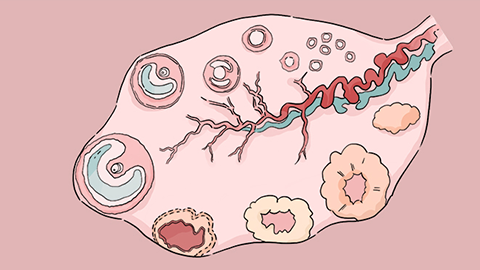What is the difference between the uterus and the ovaries?
Under normal circumstances, the uterus and ovaries differ in terms of location, shape, tissue composition, function, and common diseases. A detailed analysis is as follows:
1. Location
The uterus is located centrally in the pelvic cavity, anterior to the bladder, posterior to the rectum, and inferiorly connected to the vagina. It occupies a central position within the pelvis and is considered the core location of the female internal reproductive organs. There is one ovary on each side of the uterus; they lie adjacent to the lateral pelvic walls, near the fimbriated ends of the fallopian tubes. Their position is relatively lateral and they attach to the posterior leaf of the broad ligament.
2. Shape
The uterus is shaped like an inverted pear. In adult women, the non-pregnant uterus is approximately 7-8 cm long, 4-5 cm wide, and 2-3 cm thick, with a uterine cavity capacity of about 5 ml. It consists of two parts: the corpus and cervix, and has a relatively tough texture. The ovaries are solid,扁椭圆形 organs, measuring about 4 cm × 3 cm × 1 cm and weighing approximately 5-6 grams in adult women. The ovarian surface is smooth before puberty, but gradually becomes irregular due to repeated ovulation after puberty. After menopause, the ovaries shrink, become smaller and harder.

3. Tissue Composition
The uterus is mainly composed of smooth muscle, connective tissue, and endometrium. The endometrial layer undergoes cyclical changes with the menstrual cycle and can be divided into a functional layer and a basal layer. The ovary consists mainly of cortex and medulla. The cortex contains follicles at various stages of development, as well as structures such as the corpus luteum. The medulla primarily consists of loose connective tissue, blood vessels, and nerves.
4. Function
The uterus is the site for embryo and fetal development and for the generation of menstruation. The endometrium undergoes cyclical shedding in response to ovarian hormones, resulting in menstruation. During pregnancy, the uterus gradually enlarges to accommodate fetal growth and development, and during childbirth, uterine contractions expel the fetus and placenta. The primary functions of the ovaries are to produce and release ova and to secrete sex hormones. Estrogen promotes the development of female reproductive organs and the appearance of secondary sexual characteristics, while progesterone works in synergy with estrogen to maintain the menstrual cycle, promote embryo implantation, and support pregnancy.
5. Common Diseases
Common uterine diseases include uterine fibroids, endometrial polyps, endometritis, endometriosis, adenomyosis, and uterine prolapse. These conditions often affect menstruation or fertility. Common ovarian diseases include ovarian cysts, ovarian tumors, premature ovarian failure, and polycystic ovary syndrome. These conditions may affect ovulation and hormone secretion, leading to menstrual irregularities and infertility.
Both the uterus and ovaries are important female reproductive organs. Their functions are interdependent and together they maintain female reproductive health and physiological cycles. Regular gynecological examinations help detect abnormalities early and ensure overall health.




